ICSE Solutions for Class 6 History and Civics – The Mauryan Empire
ICSE SolutionsSelina ICSE SolutionsML Aggarwal Solutions
APlusTopper.com provides step by step solutions for ICSE Solutions for Class 6 History and Civics Chapter 8 The Mauryan Empire . You can download the History and Civics ICSE Solutions for Class 6 with Free PDF download option. History and Civics for Class 6 ICSE Solutions all questions are solved and explained by expert teachers as per ICSE board guidelines.
ICSE Solutions Class 6 History & Civics Geography Biology Chemistry Physics Maths
Exercise
I. Tick (✓) the right answer:
1. Ashoka invaded Kalinga in
(a) 261 BC
(b) 265 BC
(c) 270 BC
2. The first historical empire in India was established by
(a) Ashoka
(b) Bindusara
(c) Chandragupta
3. The Greek General whom Chandragupta defeated was
(a) Megasthenes
(b) Seleucus
(c) Alexander
4. Ashoka appointed special officers to look after the welfare of people. They were called
(a) Sthaniks
(b) Senapati
(c) Dhamma Mahamatras
5. The edicts of Ashoka were written in
(a) Sanskrit
(b) Pali
(c) Prakrit
II. Fill in the blanks:
- Chandragupta defeated the last Nanda king named Dhanananda.
- Chandragupta was helped by a Brahmin Chanakya in his conquests and administration.
- The Greek ambassador in Chandragupta’s court was named Megasthenes.
- Ashoka’s father was who ruled for Bindusara, 24
- Ashoka is famous for his policy of Dhamma.
- The battle of Kalinga changed Ashoka’s life.
- The National Emblem of India is Lion capital of Sarnath of Ashoka.
- The last Mauryan king was killed by Pushyamitra Shunga.
III. Match Column A with Column B:
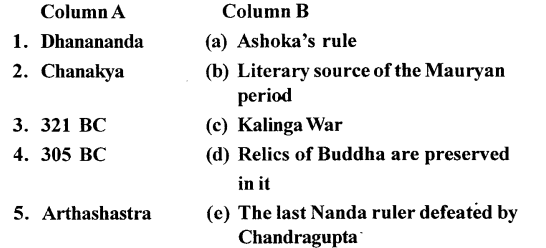

Answer:
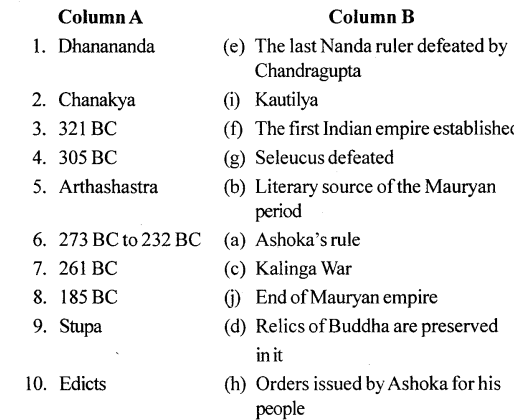
IV. Answer the following questions:
Question 1.
Who helped Chandragupta against the Nandas and why?
Answer:
Chanakya helped Chandragupta against the Nandas. Chanakya was insulted and humiliated by the Nanda king Dhanananda. Chanakya, better known as Kaufilya, trained Chandragupta, a young man of the Maurya family, in statecraft and warfare to avenge his humiliation.
Question 2.
Describe Chandragupta as a conqueror. What was the extent of his empire?
Answer:
Chandragupta Maurya annexed entire Punjab and areas across the Indus river. Seleucus had also to sign a peace treaty in which he gave away Kabul, Kandahar and Heart to Chandragupta. Chandragupta also conquered parts of central India and united the whole of Northern India under Mauryan rule,
Question 3.
Name the two literary sources of the Mauryan period. What do they tell us about the administration of the Mauryas?
Answer:
Chanakya‘s Arlhashastra tells us about how to govern an empire and describes the administration of the Mauryas. Megasthenes’s Irtdika tells us about the political, social and economic condition of people during this period, The highest functionaries were minister (Mantri), chief priest (Purohita), military commander (Senapati) and crown-prince (Yuvaraja). The king appointed 27 superintendents.
Question 4.
How did the battle of Kalinga affect Ashoka?
Answer:
Ashoka invaded Kalinga in 261 BC. The Mauryan army ultimately defeated the Kalinga army. According to an Ashoka edict 100,000 people were killed in this war and 150,000 were taken prisoners. This caused misery to many women and children. The death and destruction which followed the Kalinga war made Ashoka sad and unhappy. It became a turning point in his life. He decided he would not fight any more wars, Instead he would tiy and persuade people to live in peace.
Question 5.
Write a short note on Mauryan administration.
Answer:
Important functionaries in Mauryan administration were called tirthas. The highest functionaries were minister (Mantri), high priest (Purohita), commander- in-chief (Senapati) and crown- prince (Yuvaraja). According to the Arthashastra of Kautilya, the state appointed 27 superintendents (Adhyakshas) mostly to regulate the economic activities of the state.
V. Write short notes on:
Question 1.
(1) The measures taken by Ashoka for the welfare of his people.
(2) Mauryan art and architecture.
Answer:
- Ashoka built hospitals for both men and animals. He had a number of rest houses constructed for the benefit of travelers. Wells were also dug in many places, He also built good roads and planted shady trees on both sides.
- The Mauryan art rose to its peak during Ashoka’s rule. He built many stupas and pillars. The stupa at Sanchi is very famous, Pillars were beautifully polished almost like mirrors. Ashoka’s edicts were inscribed on rocks and stone pillars, The Sanchi Stupa, built by Ashoka is very impressive, The most famous pillar is the Sarnath Pillar, The lion capital ofthe Sarnath Pillar is carved out of a single block of stone
VI. Picture study: The picture shows Ashoka’s pillars at Firoz Shah Kotla. Find out

- Where was it originally installed ?
Ans. Topra (Haryana), - Who brought it to Delhi ?
Ans. Firoz Shah Tughlaq, - How did Ashoka use edicts to spread Dhamma in his kingdom ?
Ans. Ashoka explained Dhamma in the edicts, which were mainly written in Brahmi script, He used Prakrit, the language of the common people in these edicts. Thus, the common people could easily understand his teachings of Dhamma,
Textbook Keywords
- Indika: was the account of the Mauryan period written by Megasthenes.
- Arthashastra: The book written by Chanakya on politics. Dig vijaya It means conquest of territories.
- Dhamma vijaya: It means conquest through dharma. Dhamma It is derived from the Sanskrit word dharma, meaning religious duty.
- Dharmamahamatras: They were special officials appointed to spread and enforce the principles of dhamma.
- Mahamtras: They were officials appointed to carry out administrative work.
- Mantri parishad: It was the council of ministers who assisted the king.
- Kumaras: They were the princes of the royal family who were put in charge of important provinces.
- Grama It means village.
- Stupasl: They are solid, semicircular, dome-shaped Buddhist structures which have some relics of Buddha at their base. Viharas They were Buddhist monasteries.
- Dharma chakras: They are the wheels, carved on Ashoka’s Pillar at Samath. The wheel, representing motion and progress, is seen on the Indian national flag.
Questions Based on The Mauryan Empire
A. Fill in the blanks.
- The main literary sources of information about the Mauryan period are Indika and Arthashastra.
- In 323 BCE Dhana Nanda was overthrown by Chandragupta Maurya.
- Chandragupta’s success in acquiring the throne of Magadha was largely due to the guidance and training of his adviser Chanakya.
- In 305 BCE Alexander’s general Seleucus invaded India.
- Chandragupta Maurya was succeeded by his son Bindusara.
- When Ashoka ascended the throne of Magadha, Kalinga was the only kingdom outside Mauiyan control.
- The Kalinga war was the turning point in Ashoka’s life.
- Ashoka replaced the policy of dig vijaya with dhamma vijaya.
- The word dhamma is derived from the Sanskrit word dharma which means religious duty.
- Ashoka’s dhamma was based on human values and a code of conduct inspired by the teachings of Buddha.
B. Match the following.

![]()
Answer:

C. Answer the following.
Question 1.
What happened to Alexander’s vast empire after his death?
Answer:
After Alexander’s death, fighting broke out between his generals for the control of his vast empire, Seleucus, one of Alexander’s generals, became the ruler of the territory stretching from Asia Minor to the Indus,
Question 2.
Why was Seleucus compelled to sign a treaty with Chandragupta Maurya? Mention two important terms of this treaty.
Answer:
Seleucus was compelled to sign a treaty with Chandragupta Maurya because Chandragupta Maurya defeated him. According to this treaty he had to give eastern Afghanistan, Baluchistan and areas west of the Indus to Chandragupta. He gave his daughter to Chandragupta in marriage. In return, he received 500 war elephants.
Question 3.
What was the extent of Chandragupta’s empire?
Answer:
Chandragupta’s empire was the first great empire in Indian history. By the end of his reign, the Maurya empire stretched from the Hindu Kush in the north-west to Bengal in the east, from the Himalayas in the north to the Narmada in the south.
Question 4.
Why was the Kalinga War a turning point in the life of Ashoka?
Answer:
The Kalinga war became a turning point in Ashoka’s life, Because, the death, destruction and great human suffering in this war filled Ashoka’s heart with sorrow and remorse.
Question 5.
Mention any three principles of dhamma.
Answer:
The Principles of dhamma were as follows:
- People should live in peace and harmony,
- Everyone should follow ahimsa.
- People should be truthful, charitable and kind to all
Question 6.
What did Ashoka do to spread Buddhism outside India?
Answer:
Ashoka sent learned Buddhist scholars, his son Mahendra and daughter Saughamitra to outside India to spread message of Buddhism
Question 7.
Mention any three steps taken by Ashoka to propagate dhamma in India.
Answer:
To propagate dhamma, following steps were taken by Ashoka.
- He ordered the construction of Buddhist monasteries
- He sent learned Buddhist scholars to distant lands to spread Buddhism
- He visited all the places associated with the life of Buddha
Question 8.
What was the extent of Ashoka’s empire?
Answer:
Ashoka’s empire stretched from the Himalayas in the north to Mysore in the south and from the Hindu Kush in the north-west to Brahmaputra in the east, It also included Kabul, Kandahar, Herat and the parts of Nepal and Kashmir.
Question 9.
What are edicts? Why were they composed in Prakrit?
Answer:
Edicts are order issued by a ruler. They are also source of valuable information of the Mauryan period. They were composed in Prakrit because it was easy language to understand by the common people.
Question 10.
What did Ashoka do for the welfare of his subjects?
Answer:
He embraced Buddhism and devoted his life to the moral and material welfare of his subjects.
D. State whether the following are true of false.
- Jmlika was written by Kautilya.
False - Chanakya was a wise brahmana who had a personal grudge against Dhana Nanda.
True - Ashoka’s son was named Rahul.
False - Ashoka’s dhamma was based on the principles of Buddhism.
True
- Bindusara was the son of Ashoka.
False
E. Picture study.
1. This is an outline map of India. Mark the areas under Ashoka’s rule.
Answer:
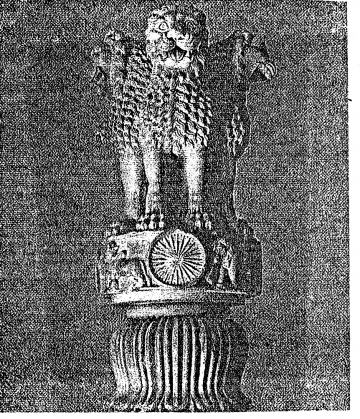
2. Name one ancient town and one modern town on the map.
Answer:
- Ancient town: Pataliputra
- Modem city Delhi.
Questions Based on The Mauryan Administration
A. Fill in the blanks.
- The Mauyran empire was divided into provinces which were placed under the control of kumaras.
- The king had supreme power. He was advised by the mantri parished.
- The provinces were divided into a number of districts which were further subdivided into nagaras and gramas.
- The capital city of Pataliputra was looked after by six committees. Each committee consisted of five members.
- Mauryan art was greatly influenced by Buddhism.
- The most famous Ashoka Pillar is at Sarnath.
- The lion capital was adopted as the emblem of India in the year 1950.
- The chief occupation of the people during the Mauryan period was agriculture.
- Two Western European countries with whom the Mauryans had trade relation were Egypt and Greece
- The last Mauryan emperor was killed by Pushyamitra Sunga the founder of the Sunga dynasty
B. Match the following.
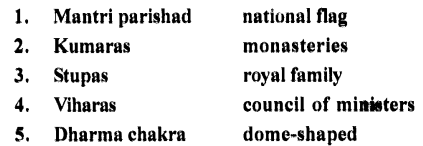
Answer:
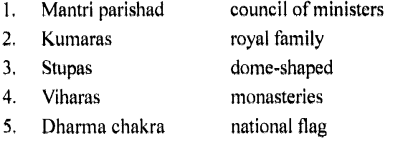
C.Answer the following questions.
Question 1.
How many committees were set up for the administration of Pataliputra? Name any three departments that were looked after by these committees.
Answer:
Six committees were set up for the adminstration for Patliputra.
Sanitation
Trade and commerce
Public utility were three departments that were looked after by these committees.
Question 2.
Mention two important features of each of the following:
- Stupas
- Monolithic pillars
- Lion capital
Answer:
- Stupas— They are solid, semicircular, dome-shaped Buddhist structures which were made of stone and bricks, They have some relics of Buddha at their base,
- Monolithic— pillarsMautryas built many Monolithic pillars, inscribed with the edicts of Ashoka. They are the best examples of the remarkable skill and quality of Mauryan artists. The surfaces of the stone pillars were highly polished. The Pillar at Samath is the most famous.
- Lion capital— The lion capital of the pillar is the most magnificent piece of sculpture of the Mauryan period. The lion capital was adopted as the national emblem of India in 1950. A picture of the lion capital can be seen on Indian currency notes.
Question 3.
Mention three important occupations of the people during the Mauryan period.
Answer:
Agriculture was main occupation of the people. Other occupations included mining, forestry and carpentry during the Mauryan Period.
Question 4.
State three important reasons for the decline of the Mauryan empire.
Answer:
There were following reasons for decline of Mauryan empire.
- Ashoka’s successors were weak and in efficient
- The empire was too vast and it was not easy to control the far-flung territories.
- In the absence of a strong central authority, the provincial viceroys declared themselves independent
D.State whether the following are true or false.
- The Mauryan administration was based on the guidelines laid down in the Indika.
False. - Pataliputra was a magnificent walled city.
True - The last Mauryan ruler was Pushyamitra Sunga
False. - There was no spy system in the Mauryan empire.
False.